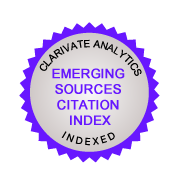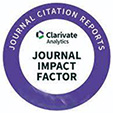In Silico Study on Interaction and Preliminary Toxicity Prediction of Eleutherine americana Components as an Antifungal and Antitoxoplasmosis Candidate
Sophi Damayanti(1*), Nadiyah Athifah Salim Martak(2), Benny Permana(3), Adi Suwandi(4), Rika Hartati(5), Indra Wibowo(6)
(1) Pharmacochemistry Research Group, School of Pharmacy, Institut Teknologi Bandung, Jl. Ganesha No. 10, Bandung 40132, West Java, Indonesia
(2) Pharmacochemistry Research Group, School of Pharmacy, Institut Teknologi Bandung, Jl. Ganesha No. 10, Bandung 40132, West Java, Indonesia
(3) Pharmacochemistry Research Group, School of Pharmacy, Institut Teknologi Bandung, Jl. Ganesha No. 10, Bandung 40132, West Java, Indonesia
(4) Research Center for Nanosciences and Nanotechnology, Institut Teknologi Bandung, Jl. Ganesha No. 10, Bandung 40132, West Java, Indonesia
(5) Pharmaceutical Biology Research Group, School of Pharmacy, Institut Teknologi Bandung, Jl. Ganesha No. 10, Bandung 40132, West Java, Indonesia
(6) Physiology Animal Development and Biomedical Science, School of Life Science and Technology, Institut Teknologi Bandung, Jl. Ganesha No. 10, Bandung 40132, West Java, Indonesia
(*) Corresponding Author
Abstract
Red bulbs of Eleutherine americana (Aubl.) Merr. ex K. Heyne has been known for its high content of naphthoquinones that have antifungal and antiparasitic activities. In this research, in silico interaction study was performed between 31 compounds reported to be found in E. americana with the selected target proteins for antifungal and antitoxoplasmosis activity using the molecular docking method. An ORPs (OSBP-related proteins), Osh4 (PDB ID: 1ZHX), and N-myristoyltransferase (Nmt, PDB ID: 1IYL) were used as the antifungal target proteins. Toxoplasma gondii purine nucleoside phosphorylase (TgPNP, PDB ID: 3MB8) and calcium-dependent protein kinase-1 (TgCDPK1, PDB ID: 4M84) were used as antitoxoplasmosis target proteins. Three-dimensional structures of the test compounds were made and optimized using GaussView 6.0 and Gaussian 09W. The target proteins were prepared using the Discovery Studio 2016 Program. Aquatic toxicity prediction as the preliminary assessment of the safety of the compounds was performed using ECOSAR v2.0. The results suggest that the compound having both the smallest free binding energy compared with positive control and other test compounds and low predicted toxicity is β-sitosterol with a free binding energy of ‒11.55 and ‒11.18 kcal/mol towards Osh4 and Nmt and ‒8.06 and ‒10.29 kcal/mol towards TgPNP and TgCDPK1, respectively.
Keywords
Full Text:
Full Text PDFReferences
[1] Seneviratne, C.J., and Rosa, E.A.R., 2016, Editorial: Antifungal drug discovery: new theories and new therapies, Front. Microbiol., 7, 728.
[2] Garibotto, F.M., Garro, A.D., Masman, M.F., Rodríguez, A.M., Luiten, P.G.M., Raimondi, M., Zacchino, S.A., Somlai, C., Penke, B., and Enriz, R.D., 2010, New small-size peptides possessing antifungal activity, Bioorg. Med. Chem., 18 (1), 158–167.
[3] Maldonado, Y.A., and Read, J.S., 2017, Diagnosis, treatment, and prevention of congenital toxoplasmosis in the United States, Pediatrics, 139 (2), e20163860.
[4] Alday, P.H., and Doggett, J.S., 2017, Drugs in development for toxoplasmosis: Advances, challenges, and current status, Drug Des. Dev. Ther., 11, 273–293.
[5] Zhang, Z., Ojo, K.K., Vidadala, R.S.R., Huang, W., Geiger, J.A., Scheele, S., Choi, R., Reid, M.C., Keyloun, K.R., Rivas, K., Siddaramaiah, L.K., Kenneth, M.C., Robinson, K.P., Merta, P.J., Kifle, L., Hol, W.G.J., Parsons, M., Merritt, E.A., Maly, D.J., Verlinde, C.L.M.J., Voorhis, W.C.V., and Fan, E., 2013, Potent and selective inhibitors of CDPK1 from T. gondii and C. parvum based on a 5-aminopyrazole-4-carboxamide scaffold, ACS Med. Chem. Lett., 5 (1), 40–44.
[6] Chen, D.L., Hu, M.G., Liu, Y.Y., Li, R.T., Yu, M., Xu, X.D., and Ma, G.X., 2018, New naphthalene derivatives from the bulbs of Eleutherine americana with their protective effect on the injury of HUVECs, Molecules, 23 (9), E2111.
[7] Kuntorini, E.M., and Nugroho, L.H., 2009, Structural development and bioactive content of red bulb plant (Eleutherine americana); A traditional medicine for local Kalimantan people, Biodiversitas, 11 (2), 102–106.
[8] Babula, P., Mikelová, R., Potĕšil, D., Adam, V., Kizek, R., Havel, L., and Sladkỳ, Z., 2005, Simultaneous determination of 1,4-naphtoquinone, lawsone, juglone and plumbagin by liquid chromatography with UV detection, Biomed. Pap., 149 (Suppl. 1), 25–28.
[9] Weinberg, R.A., McWherter, C.A., Freeman, S.K., Wood, D.C., Gordon, J.I., and Lee, S.C., 1995, Genetic studies reveal that myristoyl CoA: Protein N-myristoyltransferase is an essential enzyme in Candida albicans, Mol. Microbiol., 16 (2), 241–250.
[10] Lodge, J.K., Jackson-Machelski, E., Toffaletti, D.L., Perfect, J.R., and Gordon, J.I., 1994, Targeted gene replacement demonstrates that myristoyl-CoA: Protein N-myristoyltransferase is essential for viability of Cryptococcus neoformans, Proc. Natl. Acad. Sci. USA, 91 (25), 12008–12012.
[11] Zhong, Y., Han, X., Li, S., Qi, H., Song, Y., and Qiao, X., 2017, Design, synthesis, antifungal activity and molecular docking of thiochroman-4-one derivatives, Chem. Pharm. Bull., 65 (10), 904–910.
[12] Thenmozhi, M., and Kannabiran, K., 2013, Interaction of Streptomyces sp. VITSTK7 compounds with selected antifungal drug target enzymes by in silico molecular docking studies, Interdiscip. Sci., 5 (2), 145–149.
[13] Donaldson, T.M., Cassera, M.B., Ho, M.C., Zhan, C., Merino, E.F., Evans, G.B., Tyler, P.C., Almo, S.C., Schramm, V.L., and Kim, K., 2014, Inhibition and structure of Toxoplasma gondii purine nucleoside phosphorylase, Eukaryot. Cell, 13 (5), 572–579.
[14] Sogabe, S., Masubuchi, M., Sakata, K., Fukami, T.A., Morikami, K., Shiratori, Y., Ebiike, H., Kawasaki, K., Aoki, Y., Shimma, N., D’Arcy, A., Winkler, F.K., Banner, D.W., and Ohtsuka, T., 2002, Crystal structures of Candida albicans N-myristoyltransferase with two distinct inhibitors, Chem. Biol., 9 (10), 1119–1128.
[15] Im, Y.J., Raychaudhuri, S., Prinz, W.A., and Hurley, J.H., 2005, Structural mechanism for sterol sensing and transport by OSBP-related proteins, Nature, 437 (7055), 154–158.
[16] Insanu, M., Kusumardiyani, S., and Hartati, R., 2014, Recent studies on phytochemicals and pharmacological effect of Eleuntherine americana Merr., Procedia Chem., 13, 221–228.
[17] Alves, T.M.A., Kloos, H., and Zani, C.L., 2003, Eleutherinone, a novel fungitoxic naphthoquinone from Eleutherine bulbosa (Iridaceae), Mem. Inst. Oswaldo Cruz, 98 (5), 709–712.
[18] Komura, H., Mizukawa, K., Minakata, H., Huang, H., Qin, G., and Xu, R., 1983, New anthraquinones from Eleutherine americana, Chem. Pharm. Bull., 31 (11), 4206–4208.
[19] Zhengxiong,C., Huizhu, H., Chengrui, W., Yuhui, L., Jianmi, D., Sankawa, U., Noguchi, H., and Itaka, Y., 1986, Hongconin, a new naphthalene derivative from Hong-Cong, the rhizome of Eleutherine americana Merr. et Heyne (Iridaceae), Chem. Pharm. Bull., 34 (7), 2743–2746.
[20] Han, A.R., Min, H.Y., Nam, J.W., Lee, N.Y., Wiryawan, A., Suprapto, W., Lee, S.K., Lee, K.R., and Seo, E.K., 2008, Identification of a new naphthalene and its derivatives from the bulb of Eleutherine americana with inhibitory activity on lipopolysaccharide-induced nitric oxide production, Chem. Pharm. Bull., 56 (9), 1314–1316.
[21] Paramapojn, S., Ganzera, M., Gritsanapan, W., and Stuppner, H., 2008, Analysis of naphthoquinone derivatives in the Asian medicinal plant Eleutherine americana by RP-HPLC and LC-MS, J. Pharm. Biomed. Anal., 47 (4-5), 990–993.
[22] Mahabusarakam, W., Hemtasin, C., Chakthong, S., Voravuthikunchai, S.P., and Olawumi, I.B., 2010, Naphthoquinones, anthraquinones and naphthalene derivatives from the bulbs of Eleutherine americana, Planta Med., 76 (4), 345–349.
[23] Ieyama, T., Gunawan-Puteri, M.D.P.T., and Kawabata, J., 2011, α-Glucosidase inhibitors from the bulb of Eleutherine americana, Food Chem, 128 (2), 308–311.
[24] Xu, J., Qiu, F., Duan, W., Qu, G., Wang, N., and Yao, X., 2006, New bioactive constituents from Eleutherine americana, Front. Chem. China, 1 (3), 320–323.
[25] Cole, J.C., Murray, C.W., Nissink, J.W.M., Taylor, R.D., and Taylor, R., 2005, Comparing protein-ligand docking programs is difficult, Proteins Struct. Funct. Bioinf., 60 (3), 325–332.
[26] Mayo-Bean, K., Moran-Bruce, K., Meylan, W., Ranslow, P., Lock, M., Nabholz, J.V., Von Runnen, J., Cassidy, L.M., and Tunkel, J., 2017, Methodology Document for the ECOlogical Structure-Activity Relationship Model (ECOSAR) Class Program Version 2.0, U.S. Environmental Protection Agency, Washington DC.
[27] United States Environmental Protection Agency, 2013, Interpretive assistance document for assessment of discrete organic chemicals, U.S. EPA, Washington, 5.
[28] Kiprono, P.C., Kaberia, F., Keriko, J.M., and Karanja, J.N., 2000, The in vitro anti-fungal and anti-bacterial activities of ß-sitosterol from Senecio lyratus (Asteraceae), Z. Naturforsch., C: Biosci., 55 (5-6), 485–488.
[29] Saeidnia, S., Manayi, A., Gohari, A.R., and Abdollahi, M., 2014, The story of beta-sitosterol –A review, Eur. J. Med. Plants, 4 (5), 590–609.
Article Metrics
Copyright (c) 2019 Indonesian Journal of Chemistry

This work is licensed under a Creative Commons Attribution-NonCommercial-NoDerivatives 4.0 International License.
Indonesian Journal of Chemistry (ISSN 1411-9420 /e-ISSN 2460-1578) - Chemistry Department, Universitas Gadjah Mada, Indonesia.












